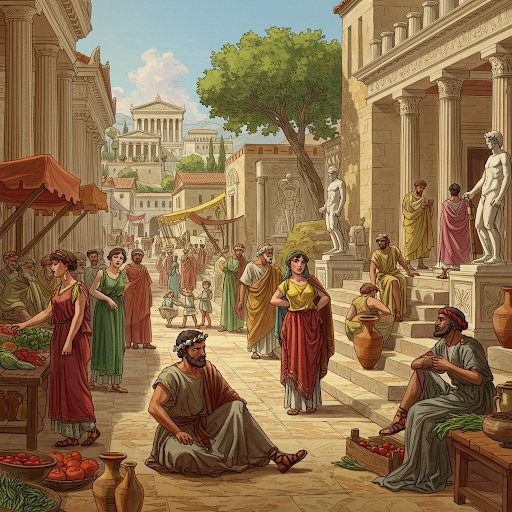The Hellenistic period (323–31 BCE) marked an era of cultural fusion and innovation following the conquests of Alexander the Great. His vast empire fragmented into three major Hellenistic kingdoms:
Ptolemaic Egypt (Egypt, parts of Libya, and the Levant).
Seleucid Empire (Mesopotamia, Persia, Syria, and parts of Central Asia).
Antigonid Macedonia (Greece and parts of the Balkans).
These kingdoms blended Greek and local traditions, creating unique societies with diverse economies, religions, arts, and daily customs. This article explores the daily lives of people in the Hellenistic world, focusing on society, occupations, family life, education, religion, food, clothing, entertainment, and warfare.
1. Society and Social Hierarchy
Hellenistic societies were highly stratified, with Greek elites at the top and native populations often holding lower status.
Social Classes
The King and Royal Court – The monarch wielded absolute power, controlling the government, military, and economy.
Greek and Macedonian Nobility – Administrators, generals, and scholars, often settled in newly founded cities.
Merchants and Artisans – Greek and local traders, craftsmen, and bankers who benefited from economic expansion.
Farmers and Laborers – The majority of the population, working in agriculture, fishing, and construction.
Slaves and Servants – Many were war captives or debt slaves, working in households, farms, and mines.
Despite these divisions, cultural assimilation occurred, as Greeks intermarried with locals and adopted native customs.
Government and Administration
The Hellenistic kings ruled as divine monarchs, influenced by Persian and Egyptian traditions.
Large bureaucracies managed taxation, trade, and public works.
Cities like Alexandria, Antioch, and Pergamon were centers of governance and culture.
2. Family Life and Gender Roles
Marriage and Family Structure
Marriage was a social contract, often arranged to secure wealth and alliances.
Greek men frequently married local women, especially in Egypt and Persia.
Families were patriarchal, but women had greater rights in Ptolemaic Egypt than in Greece.
Women in Society
Upper-class women in Egypt could own property, manage businesses, and engage in politics.
In the Seleucid and Antigonid kingdoms, women had fewer rights, mostly managing households.
Some royal women, like Cleopatra VII, played crucial political roles.
Children were raised to value Greek education, military training, and religious traditions.
3. Economy and Occupations
Agriculture and Farming
Wheat, barley, olives, and grapes were staple crops.
Ptolemaic Egypt was the breadbasket of the Mediterranean, exporting grain to Greece and Rome.
Irrigation and advanced farming techniques boosted production.
Trade and Commerce
The Hellenistic world was deeply connected through Mediterranean and Silk Road trade.
Major exports: Textiles, papyrus, spices, perfumes, and glassware.
Major imports: Silver, silk, incense, and luxury goods from India and Persia.
Coinage was standardized, and banks facilitated loans and investments.
Crafts and Industry
Artisans produced pottery, metalwork, and sculptures in Greek and local styles.
Alexandria was known for glassmaking, shipbuilding, and textile production.
Cities thrived as centers of commerce, culture, and technological innovation.
4. Urban and Rural Life
Cities: Centers of Culture and Power
Alexandria (Egypt), Antioch (Syria), and Pergamon (Asia Minor) were vibrant metropolises.
Cities had theaters, gymnasiums, temples, and marketplaces (agoras).
Greek-style houses had courtyards, frescoes, and mosaics, while native homes followed traditional designs.
Village and Countryside Life
Most people lived in rural villages, working as farmers, herders, or craftsmen.
Village homes were simple, made of mudbrick or stone, with communal wells and granaries.
Farmers paid taxes to the king, often through grain or labor.
Despite urban growth, the majority of people remained tied to the land.
5. Education and Philosophy
Greek Education (Paideia)
Boys from elite families attended gymnasiums, learning rhetoric, philosophy, mathematics, and physical training.
Scholars studied at the Library of Alexandria, the greatest intellectual center of the time.
Hellenistic philosophy evolved with Stoicism, Epicureanism, and Skepticism influencing daily thought.
Scientific Advancements
Archimedes (mathematics and engineering)
Eratosthenes (geography and astronomy)
Hippocrates and Herophilos (medicine and anatomy)
Education and science flourished under royal patronage.
6. Religion and Beliefs
Greek and Local Religious Fusion
Greek gods (Zeus, Apollo, Athena) were worshipped alongside Egyptian, Persian, and Mesopotamian deities.
Serapis, a fusion of Zeus and Osiris, became a major Hellenistic god.
Mystery cults (e.g., Isis cult) gained popularity, offering spiritual salvation.
Temple Worship and Festivals
Grand temples, like the Temple of Zeus in Pergamon, were built in Greek and Eastern styles.
Public festivals included the Olympic Games, Dionysian feasts, and Ptolemaic royal celebrations.
Religion reinforced political power, social unity, and cultural blending.
7. Food and Cuisine
Common Diet
Grain-based bread and porridge were staples.
Olives, cheese, honey, and vegetables supplemented meals.
Meat (goat, lamb, fish) was eaten during festivals or by the wealthy.
Dining Customs
The Greek symposium (banquet) remained popular among elites.
Wine was diluted with water and often flavored with herbs.
Food reflected the Mediterranean diet, with influences from Persia and Egypt.
8. Entertainment and Leisure
Theater and Art
Greek tragedies and comedies remained popular in cities.
Statues, frescoes, and mosaics depicted both Greek myths and local traditions.
Sports and Athletics
Gymnasiums and palestras (wrestling schools) trained young men.
Gladiatorial games started appearing, influenced by Rome and the East.
Entertainment blended Greek traditions with local influences.
9. Military and Warfare
Hellenistic Armies
The phalanx (Macedonian battle formation) was the core of armies.
War elephants, inspired by India, were used by Ptolemaic and Seleucid forces.
Mercenaries from Greece, Thrace, and Persia filled military ranks.
Naval Power
Alexandria’s fleet controlled the Mediterranean.
Warships like the trireme and quinquereme ensured dominance.
Frequent wars between the Hellenistic kingdoms and Rome led to their eventual decline.
10. Decline of the Hellenistic Kingdoms
By 31 BCE, Rome conquered the last Hellenistic kingdom, Ptolemaic Egypt, marking the end of the era. The legacies of Hellenistic culture lived on in Roman art, science, and philosophy.
Conclusion
Daily life in the Hellenistic world was shaped by Greek and local traditions, with advancements in education, trade, religion, and art. From the bustling streets of Alexandria to the farms of Macedonia, the Hellenistic kingdoms created a unique civilization that influenced the Mediterranean and beyond.







